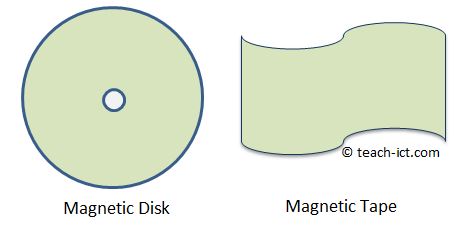Secondary storage
3. Magnetic storage
This uses minute magnetic particles or 'domains' to store data.
A hard disk is an example of a magnetic storage device. It contains several platters on a spindle, spinning at high speed, with read/write heads floating just above the surface.
Another example of magnetic storage is a magnetic tape cartridge.

| Advantages of magnetic storage | Disadvantages of magnetic storage |
|---|---|
| Huge capacity, offers up to several terabytes per device. | Not as portable as other technologies. But external hard disks are commonly available, but they need to be treated carefully. |
| Low cost per gigabyte - magnetic tape is the cheapest, but hard disk is very low as well. | Hard disk has mechanical moving parts, so less rugged than solid state storage. |
| Hard Disk offers high speed data access | Data can be lost near strong magnetic fields, such as being too near an audio speaker. |
| Hard Disk offers random access to data | Magnetic tape uses serial data access and so is very slow. |
| Magnetic tape can hold its data for up to thirty years in the correct environment. | Data read \ write is not as fast as flash technology |
Challenge see if you can find out one extra fact on this topic that we haven't already told you
Click on this link: Magnetic storage examples
